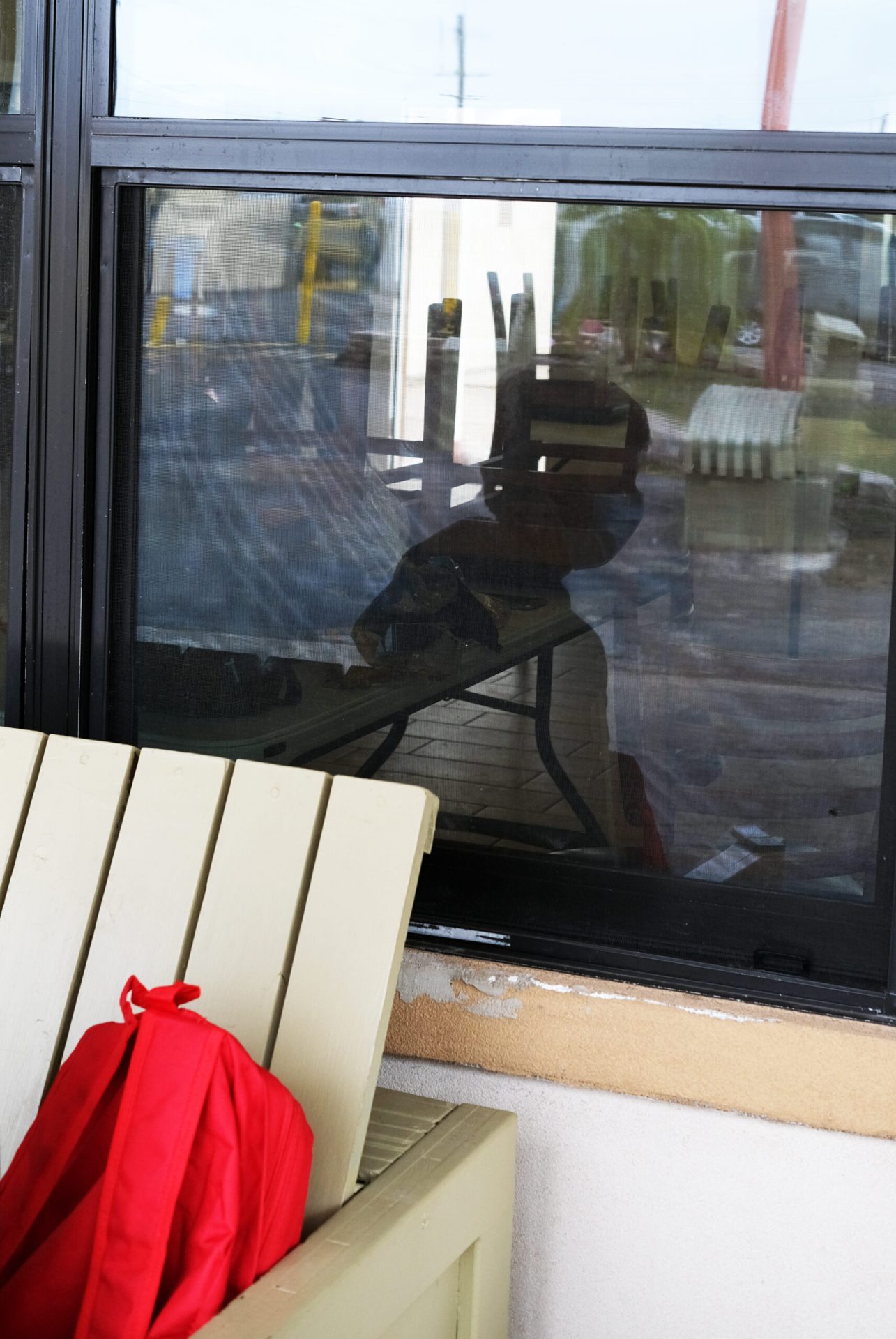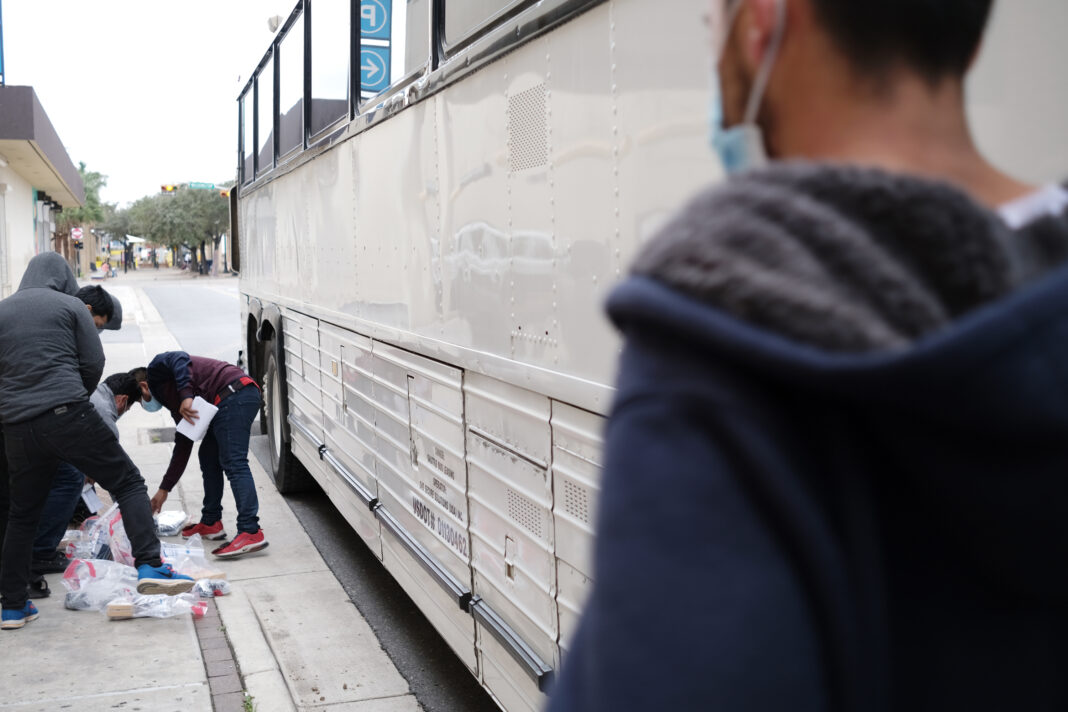Nonprofit organizations helping migrants released from federal custody in Brownville noticed a shift in demographic at the start of the year: More men traveling alone are released there than migrant families.
Though there is no official explanation, some external factors may be contributing to the change.
OZANAM SHELTER
Paper stacked like buildings form a miniature landscape on Myrna M. Garza’s desk, the shelter manager at the Ozanam Center in Brownsville. Every day forms documenting each asylum seeker released from custody to the center come into her office and grow into piles that Garza inputs into her computer, files away, and clears from her desk.
Lately, the forms keep coming.
Last month, Garza processed about 350 forms for migrants, mainly families, released to the shelter to receive assistance like clothing, shoes and shelter. January was different.
“It has changed,” Victor Maldonado, Ozanam’s executive director, affirmed. “Before we were looking at entire families, or maybe single females with two or three kids, and single males with kids. And now, it’s kind of shifting with single individuals.”
By Wednesday, they’ve processed 500. Garza estimated 90% of them were single men; most are from Nicaragua and Honduras.
The increase was unexpected. Donated clothes and shoes quickly ran out.
“We have really not had any jackets or heavy clothes for them. And, that’s what we are wanting at this point,” Maldonado said.
Jackets, shoes and small-waisted pants for men are in high demand. Maldonado asked the public to donate to their shelter located at 656 N. Minnesota Ave. in Brownsville.
Some long-term residents, like a 28-year-old Venezuelan man, work while they wait to gather enough money to buy a ticket to their destination further into the U.S.
PERSONAL JOURNEY
Luis, a 28-year-old Venezuelan migrant man, resides in Ozanam until his scheduled flight in mid-February. His name and identity are not disclosed, due to the dangers he faced along the way and the possibility of being deported.
“I don’t even know how I got here,” Luis said, referring to the close calls, the long journey and the sacrifices he made along the way.

People who come to the U.S. many times will cite their children as the motivation to seek a better life.
Luis, a young man, has an inverted cause.
“I want to help my parents, because they’re older. My dad is 71, and my mom is 65. I want to give them a good life the way they gave it to me when I was younger,” he said.
In eight months, Luis traversed 10 countries, after living in Peru for a while.
He cheated death twice. Luis was kidnapped for 10 days by the cartel in Nuevo Laredo, and escaped the custody of natives living in the tumultuous region between Colombia and Panama where he witnessed four other migrants slaughtered before him.
“I got to Mexico weighing about 44 kilograms,” or 97 pounds, Luis said.
Unlike many who cross the river, Luis did so without paying smugglers. Normally, migrants are charged a fee and given a password to secure safe passage. Instead, on Dec. 20, Luis made a run for it under the international bridge in Reynosa.
He was held for eight days before he was released from federal custody on his own recognizance with a notice to appear at an immigration court in March. Luis, with about 50 other men, mostly from Nicaragua, arrived in Ozanam where they took them in, as they have with all other men currently being released.
CONTRIBUTING FACTORS
There’s no defining answer to explain the increase of men released from federal custody, unlike the families released last year when Mexican border states imposed limitations on ages of children they’d accept from the U.S. But, there are two factors.
More people are coming in and more are getting sick while they’re in federal custody.
Over the weekend, Border Patrol agents apprehended groups totaling over 420 people in Cameron County.
“We rarely see that in Brownsville,” Acting Assistant Chief Patrol Agent Christian Alvarez said. “It’s things that we don’t normally see in the eastern portion of our sector. That’s very common for the western portion like in McAllen, Roma, Rio Grande City.”
Overall, Border Patrol apprehensions went up from about 167,000 in November to 170,000 in December, according to the latest government data.
“We’re still the number one sector nationwide,” Alvarez said, referring to the Rio Grande Valley sector. Other areas, like Del Rio and Yuma, also saw higher numbers last month.
Once migrants are in custody, Border Patrol agents can turn them back to Mexico under Title 42, a public health policy re-introduced during the pandemic. Others can be referred to Title 8 processing with the Department of Homeland Security where migrants can be sent to be held in ICE custody or released on their own recognizance with a future immigration court date.
The men who are currently released in Brownsville are leaving ICE’s custody, not Border Patrol.
Lately, however, many who were sent to ICE facilities became sick with the COVID-19 virus.
About a month ago, there were only 250 cases reported in detention facilities across the country. By Tuesday, the number went up by 980% to 2,702 cases.
The facilities with the highest levels of infection were all in Texas claiming almost 60% of all cases.
ICE provided a statement that said they are prioritizing certain migrants for removal.
“U.S. Immigration and Customs Enforcement (ICE) focuses its civil immigration enforcement priorities on the apprehension and removal of noncitizens who pose a threat to national security, public safety, and border security,” according to the ICE spokesperson’s statement. “Noncitizens processed under Title 8 are evaluated for a custodial determination based on their immigration and criminal background, applicable sections of law, and established processing criteria. Individuals deemed suitable for release are released in coordination with local partners and are subject to reporting requirements associated with their immigration proceedings.”
Migrants released at the Ozanam Center are negative cases, the shelter manager said. Those who are released are either tested by ICE or by the city when they’re dropped off in Brownsville.

BROWNSVILLE DROP OFF
A bus carrying about a dozen migrants pulled in and parked across from the bus station in downtown Brownsville around 12:40 p.m. A contract security officer got down and pulled out plastic baggies with personal belongings of the passengers.
People came out of the bus in small groups — some with ankle monitors, others with government-tracked cellphones — and walked to the bags laid out in the concrete. After claiming their property, they moved into a building where a myriad of nongovernmental organizations, like Good Neighbor Settlement House and Team Brownsville volunteers were waiting to help receive them and guide them to their next destination.
Some purchase bus tickets, others plane tickets, and some are taken to Ozanam where they can sleep overnight and plan their next steps under government surveillance.




